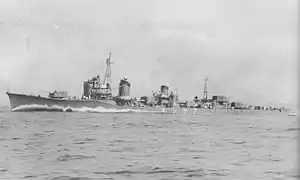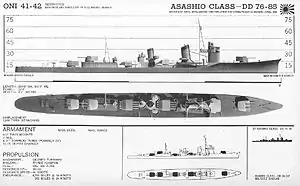 Asashio underway in July 1937. | |
| Class overview | |
|---|---|
| Name | Asashio class |
| Builders |
|
| Operators | |
| Preceded by | Shiratsuyu class |
| Succeeded by | Kagerō class |
| Built | 1937–1939 |
| In commission | 1939–1945 |
| Completed | 10 |
| Lost | 10 |
| General characteristics | |
| Type | Destroyer |
| Displacement | 2,370 long tons (2,408 t) |
| Length |
|
| Beam | 10.3 m (33 ft 10 in) |
| Draft | 3.7 m (12 ft 2 in) |
| Propulsion | 2-shaft geared turbine, 3 boilers, 50,000 shp (37,285 kW) |
| Speed | 35 knots (40 mph; 65 km/h) |
| Range | |
| Complement | 200 |
| Armament |
|

The Asashio-class destroyers (朝潮型駆逐艦, Asashio-gata kuchikukan) were a class of ten destroyers of the Imperial Japanese Navy in service before and during World War II.[1] The overall layout of the class proved successful in service and created a powerful ship that served as the basis for the design of the following two classes of destroyers.[2]
Background
The Imperial Japanese Navy was not entirely satisfied with the performance of the Shiratsuyu-class destroyer, particularly in terms of operational range and speed. However, given the limitations of the 1930 London Naval Treaty, it was considered impossible to modify these vessels any further to improve their specifications. This obstacle was removed after the Japanese government decided to allow the treaty to expire without renewal.[2] The final four vessels of a projected 14 destroyers in the Shiratsuyu class were cancelled, and the larger new Asashio-class vessels were approved under the Maru-2 Supplementary Naval Expansion Budget of 1934, with construction spanning 1937-1939 as the treaty did not officially expire until December 31, 1936. All ten vessels were lost in the Pacific War.[3]
Design
The Asashio-class was the first Japanese destroyer class to exceed 2,000 tons displacement and the first to be equipped with sonar. The hull was 30 feet longer than the Shiratsuyu-class and displacement was increased by 300 tons.
The Asashio-class was powered by two steam turbine engines with two shafts, powered by three boilers, which operated at higher temperatures than the Shiratsuyu-class. The rated output of these engines was 50,000 hp (37,000 kW), which gave the class a top speed of 35 knots (65 km/h) and a range of 5,700 nautical miles (10,600 km) at 15 knots (28 km/h) or 960 nautical miles (1,780 km) at 34 knots (63 km/h).[4] The Asashio-class was thus one knot faster than the Shiratsuyu-class despite the larger size and displacement of the vessels. However, during sea trials, early critical issues were discovered, especially with the reliability of the new steam turbines. Another issue was with design of the rudder, which initially led to problems with the ship's turning radius. These issues were addressed by the start of the Pacific War with a modified stern and rudder.[2]
Armament
In terms of armament, the Asashio class reverted to the previous Fubuki main battery layout of 3 twin mount 12.7 cm/50 Type 3 naval guns, instead of the 5-gun design of the more recent Shiratsuyu and Hatsuharu classes that were constructed under treaty limitations. There was one twin turret forward of the bridge and a superfiring pair of twin turrets aft. The guns were capable of 55-degree elevation. Also, the position of the "X" turret at the shelter deck level forward of the quarterdeck "Y" turret, gave the Asashio class a different silhouette than the Shiratsuyu class, where both turrets were at quarterdeck level.
The torpedo armament eight Type 93 torpedo in two quadruple launchers as on the Shiratsuyu-class was retained, with eight reloads stored in a deckhouse on the centerline of the ship. At the start of the war, the Asashio-class was also equipped with 16 depth charges, while previous classes carried 18. Later in the war, the number of depth charges was increased to 36, and to compensate for the weight, one set of four torpedo reloads was removed.[2]
In terms of anti-aircraft capability, initially two twin-mount Type 96 AA guns were placed forward of the second smokestack. The Asashio-class was the first destroyers to receive this type of gun.[2] As the war progressed, the number of Type 96 guns was gradually increased. In 1942-1943, the twin-mounts were replaced by triple-mounts, and another twin-mount was added forward of the bridge. From 1943-1944, on surviving vessels the superfiring "X" turret was removed and replaced by two more triple-mounts. After 1944, surviving vessels were fitted with between eight and twelve additional single-mounts, and Kasumi received also two Type 93 13mm machine guns. In late 1944, the final four survivors (Kasumi, Michishio, Asagumo, and Yamagumo) received a Type 22 and a Type 13 radar.[2]
Operational history
During the war the Asashio class was used extensively in the protection of the Combined Fleet. Arare was attacked and sunk off Kiska Island during the Aleutian Islands Campaign by USS Growler on 5 July 1942. Kasumi was also heavily damaged along with one other destroyer. Asashio and Arashio escorted the 7th Cruiser Division at the Battle of Midway, where both were damaged by air attack. Although repaired and returned to service, both were sunk in 1943 when a large Japanese transport force was destroyed by American planes in the Battle of the Bismarck Sea. Michishio, Asagumo, and Yamagumo were lost in 1944 in the Battle of Leyte Gulf. Kasumi, last of the class to be laid down, served as escort on the attack on Pearl Harbor and joined the battleship Yamato during Operation Ten-Go against the American fleet at Okinawa. None of the Asashio-class ships survived the Pacific War.[5]
List of ships
| Kanji | Ship | Shipyard | Laid down | Launched | Completed | Fate |
|---|---|---|---|---|---|---|
| 朝潮 | Asashio | Sasebo Naval Arsenal | 7 September 1935 | 16 December 1936 | 31 August 1937 | Air strike in the Battle of the Bismarck Sea, 4 March 1943 at 07°15′S 148°15′E / 7.250°S 148.250°E |
| 大潮 | Ōshio | Maizuru Naval Arsenal | 5 August 1936 | 19 April 1937 | 31 October 1937 | Torpedoed, 20 February 1943 (Solomon Islands campaign) at 00°50′S 146°06′E / 0.833°S 146.100°E |
| 満潮 | Michishio | Fujinagata Shipyards | 5 November 1935 | 15 March 1937 | 31 October 1937 | Surface action in the Battle of Surigao Strait, 25 October 1944 at 10°25′N 125°23′E / 10.417°N 125.383°E |
| 荒潮 | Arashio | Kawasaki-Kobe | 1 October 1935 | 26 May 1937 | 30 December 1937 | Air attack in the Battle of the Bismarck Sea, 4 March 1943 at 07°15′S 148°30′E / 7.250°S 148.500°E |
| 朝雲 | Asagumo | 23 December 1936 | 5 November 1937 | 31 March 1938 | Surface action in the Battle of Surigao Strait, 25 October 1944 at 10°04′N 125°21′E / 10.067°N 125.350°E | |
| 山雲 | Yamagumo | Fujinagata Shipyards | 4 November 1936 | 24 July 1937 | 15 January 1938 | Surface action in the Battle of Surigao Strait, 25 October 1944 at 10°25′N 125°23′E / 10.417°N 125.383°E |
| 夏雲 | Natsugumo | Sasebo Naval Arsenal | 1 July 1936 | 26 May 1937 | 10 February 1938 | Air attack in the Battle of Cape Esperance, 12 October 1942 at 08°40′S 159°20′E / 8.667°S 159.333°E |
| 峯雲 | Minegumo | Fujinagata Shipyards | 22 March 1937 | 4 November 1937 | 30 April 1938 | Surface action in the Battle of Blackett Strait, 5 March 1943 at 08°01′S 157°14′E / 8.017°S 157.233°E |
| 霰 | Arare | Maizuru Naval Arsenal | 5 March 1937 | 16 November 1937 | 15 April 1939 | Torpedoed, 5 July 1942 (Aleutian Islands campaign) at 52°0′N 177°40′E / 52.000°N 177.667°E |
| 霞 | Kasumi | Uraga Dock Company | 1 December 1936 | 18 November 1937 | 24 June 1939 | Operation Ten-Go, 7 April 1945 at 31°N 128°E / 31°N 128°E |
See also
Notes
- ↑ Jentsura, Warships of the Imperial Japanese Navy, 1869-1945
- 1 2 3 4 5 6 Stille, Mark (2013). Imperial Japanese Navy Destroyers 1919–45 (2). Oxford, UK: Osprey Publishing. pp. 5–9. ISBN 978-1-84908-987-6.
- ↑ Globalsecurity.org, IJN Shiratsuyu class destroyers
- ↑ Roger Chesneau, ed. (1980). Conway's All the World's Fighting Ships 1922-1946. Grenwitch: Conway Maritime Press. ISBN 0-85177-146-7.
- ↑ Brown, David (1990). Warship Losses of World War Two. Naval Institute Press. ISBN 1-55750-914-X.
- ↑ Nishida, Hiroshi. "Materials of IJN: Shiratsuyu class destroyer". Imperial Japanese Navy. Archived from the original on 2012-07-22. Retrieved 2010-07-24.
Books
- Evans, David (1979). Kaigun: Strategy, Tactics, and Technology in the Imperial Japanese Navy, 1887-1941. US Naval Institute Press. ISBN 0-87021-192-7.
- Brown, David (1990). Warship Losses of World War Two. Naval Institute Press. ISBN 1-55750-914-X.
- Roger Chesneau, ed. (1980). Conway's All the World's Fighting Ships 1922-1946. Grenwitch: Conway Maritime Press. ISBN 0-85177-146-7.
- Howarth, Stephen (1983). The Fighting Ships of the Rising Sun: The Drama of the Imperial Japanese Navy, 1895–1945. Atheneum. ISBN 0-689-11402-8.
- Jentsura, Hansgeorg (1976). Warships of the Imperial Japanese Navy, 1869–1945. US Naval Institute Press. ISBN 0-87021-893-X.
- Watts, A.J. (1966). Japanese warships of World War II. Ian Allan. ISBN 0711002150.
- Whitley, M. J. (1988). Destroyers of World War 2. Cassell Publishing. ISBN 1-85409-521-8.
External links
- Nishida, Hiroshi. "Materials of IJN: Asashio class destroyer". Imperial Japanese Navy. Archived from the original on 2012-07-21. Retrieved 2010-07-24.
- Globalsecurity.org. "IJN Asashio class destroyers".